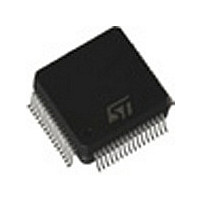STV0299B STMicroelectronics, STV0299B Datasheet - Page 15

STV0299B
Manufacturer Part Number
STV0299B
Description
Manufacturer
STMicroelectronics
Datasheet
1.STV0299B.pdf
(36 pages)
Specifications of STV0299B
Pin Count
64
Screening Level
Commercial
Lead Free Status / Rohs Status
Specific Sites Compliant
Available stocks
Company
Part Number
Manufacturer
Quantity
Price
Part Number:
STV0299B
Manufacturer:
ST
Quantity:
20 000
Company:
Part Number:
STV0299BL
Manufacturer:
MICRON
Quantity:
10 000
Part Number:
STV0299BLT
Manufacturer:
ST
Quantity:
20 000
4
4.6 Forward Error Correction
4.6.1
Since the STV0299B is a multistandard decoder,
several combinations are possible, at different
levels:
• The demodulator may accept either QPSK or
• There two primary options concerning the FEC
• There are two options concerning the FEC
The FEC Mode Register is in Address 28.
In Modes DVB and DSS, data is fed to the Viterbi
decoder. Other parts of the decoding (such as the
Convolutional Deinterleaver) may be bypassed.
4.6.2
The convolutive codes are generated by the
polynomial G
modes DVB or DSS.
The Viterbi decoder computes for each symbol
the metrics of the four possible paths, proportional
to the square of the Euclidian distance between
the received I and Q and the theoretical symbol
value.
The puncture rate and phase are estimated on the
error rate basis. Several rates are allowed and
may
programming:
• 1/2, 2/3, 3/4, 5/6, 7/8 in DVB.
• 1/2, 2/3, 3/4, 5/6 and 6/7 in DSS.
For each enabled rate, the current error rate is
compared to a programmable threshold. If it is
greater than this threshold, another phase (or
another rate) is tried until the right rate is obtained.
A programmable hysteresis is added to avoid
losing the phase during short term perturbation.
The rate may also be imposed by external
software, and the phase is incremented only upon
request by the microprocessor. The error rate may
be read at any time in order to use an algorithm
other than that implemented.
The Viterbi decoder produces an absolute
decoding. The decoder is controlled via several
Viterbi Threshold Registers (Registers 29, 2A, 2B,
BPSK signals - the only impact is on the carrier
algorithm choice (refer to Chapter 4.4).
The algorithm choice also affects the carrier
lock detector and the noise evaluation.
operation - between DVB, DSS and Reserved
Mode.
feeding. The first is IQ flow, which is the usual
case in QPSK modes DVB or DSS. The second
mode is I-only flow, used for BPSK.
FUNCTIONAL DESCRIPTION (continued)
be
FEC Modes
Viterbi Decoder and Synchronization
enabled/disabled
x
= 171 octets and G
through
y
= 133 octets in
register
2C and 2D). For each Viterbi Threshold Register,
bits 6 to 0 represent an error rate threshold - the
average number of errors occurring during 256-bit
periods. The maximum programmable value is
127/256 (higher error rates are of no practical
use).
The Puncture Rate and Synchro Register is in
Address 31.
The automatic rate research is only done through
the enabled rates (see the corresponding bit set in
the Puncture and synchro register). In DSS, the
puncture rate 6/7 replaces the puncture rate 7/8.
In DSS, it is recommended that you disable
puncture rates 3/4 and 5/6 in order to save time in
the synchronization process.
The VSEARCH Register is in Address 32.
VSEARCH bit 7 (A/M) and bit 6 (F) programs the
automatic/manual (or computer aided) search
mode as follows:
• If A/M =0 and F=0, automatic mode is set.
• If A/M=0 and F=1, the current puncture rate is
• If AM=1 manual mode is set. In this case, only
The reset values are A/M=0, and F=0 (automatic
search mode).
The VERROR Register (a read only register) is in
Address 26. The last value of the error rate may
be read at any time in the register. Unlike the VTH,
the possible range is from 0 to 255/256.
The VSTATUS Register (a read only register) is in
Address 1B.
Successive enabled punctured rates are tried
with all possible phases, until the system is
locked and the block synchro found. This is the
default (reset) mode.
frozen. If no sync is found, the phase is
incremented,
This mode allows shortening of the recovery
time in case of noisy conditions. The puncture
rate is not supposed to change in a given
channel.
implementation,
automatic mode. The microprocessor reads the
error rate or the PRF flag in order to detect the
capture of a signal, then it switches F to 1, until
a new channel is requested by the remote
control.
one puncture rate should be validated -
the system is forced to this rate, on the current
phase, ignoring the time-out register and the
error rate. In this mode, each 0 to 1 transition of
the bit F leads to a phase incrementation,
allowing full control of the operation by an
external microprocessor by choosing the lowest
error rate.
In
but
a
the
not
typical
research
the
computer-aided
rate
STV0299B
begins
number.
15/36
in













